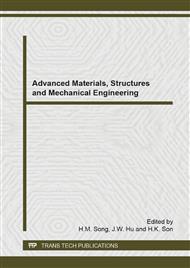p.661
p.668
p.672
p.677
p.683
p.688
p.693
p.697
p.703
The Synthesis and Properties of Emulsion Copolymerization of Styrene with N-Substituted Phenyl Maleimide
Abstract:
The synthesis and characterization of copolymer emulsions of styrene with two types of N-substituted phenyl maleimide (N-p-Methyl–MPhMI and N-m-Methyl–MPhMI) were investigated and researched in this thesis, by varying the mole fraction of N-substituted phenyl maleimide and using a seed emulsion polymerization process. The emulsion was steady with high yield, low intrinsic viscosity, and high solid content (40%). In this thesis, we studied that the substituted position on the benzene ring of the N - substituted phenyl maleimide has significant influence on emulsion properties and thermal properties of copolymer emulsion copolymer. The result shows that: the polarity of N-p-MPhMI is higher than N-m-MPhMI, which can significantly improve the yield, and reduces the emulsion gel rate. N-p-MPhMI is more electronegative than N-m-MPhMI, and N-p-MPhMI-St copolymer emulsion has high zero shear viscosity and low surface tension than N-m-MPhMI-St. And N-m-MPhMI-St copolymer emulsion decreased the viscosity of Pst homopolymer emulsion. However, N-p-MPhMI-St copolymer emulsion rheology curve changes into pseudoplastic fluid. The addition of the N-substituted phenyl maleimide can improve the heat resistance of polystyrene, and N-p-methylphenyl maleimide with styrene copolymer can increase the glass transition temperature of copolymer more remarkably than copolymer N- m-tolylmaleimide with styrene can do.
Info:
Periodical:
Pages:
683-687
Citation:
Online since:
September 2014
Authors:
Price:
Сopyright:
© 2014 Trans Tech Publications Ltd. All Rights Reserved
Share:
Citation:


